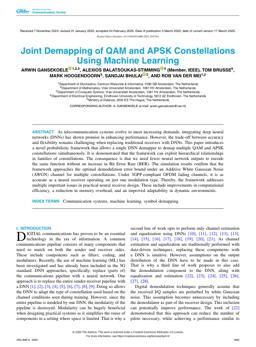2025-03-03
Joint demapping of QAM and APSK constellations using machine learning
Publication
Publication
IEEE Open Journal of the Communications Society , Volume 6 p. 1695- 1709
As telecommunication systems evolve to meet increasing demands, integrating deep neural networks (DNNs) has shown promise in enhancing performance. However, the trade-off between accuracy and flexibility remains challenging when replacing traditional receivers with DNNs. This paper introduces a novel probabilistic framework that allows a single DNN demapper to demap multiple QAM and APSK constellations simultaneously. It is demonstrated that the framework can exploit hierarchical relationships in families of constellations. The consequence is that we need fewer neural network outputs to encode the same function without an increase in Bit Error Rate (BER). The simulation results confirm that the framework approaches the optimal demodulation error bound under an Additive White Gaussian Noise (AWGN) channel for multiple constellations. Under 3GPP-compliant OFDM fading channels, it is as accurate as a neural receiver operating on just one modulation type. Thereby, the framework addresses multiple important issues in practical neural receiver design. These include improvements in computational efficiency, a reduction in memory overhead, and an improved adaptability in dynamic environments.
| Additional Metadata | |
|---|---|
| , , | |
| doi.org/10.1109/OJCOMS.2025.3547261 | |
| IEEE Open Journal of the Communications Society | |
| Organisation | Centrum Wiskunde & Informatica, Amsterdam (CWI), The Netherlands |
|
Gansekoele, A., Balalsoukas-Slimming, A., Brusse, T., Hoogendoorn, M., Bhulai, S., & van der Mei, R. (2025). Joint demapping of QAM and APSK constellations using machine learning. IEEE Open Journal of the Communications Society, 6, 1695–1709. doi:10.1109/OJCOMS.2025.3547261 |
|

